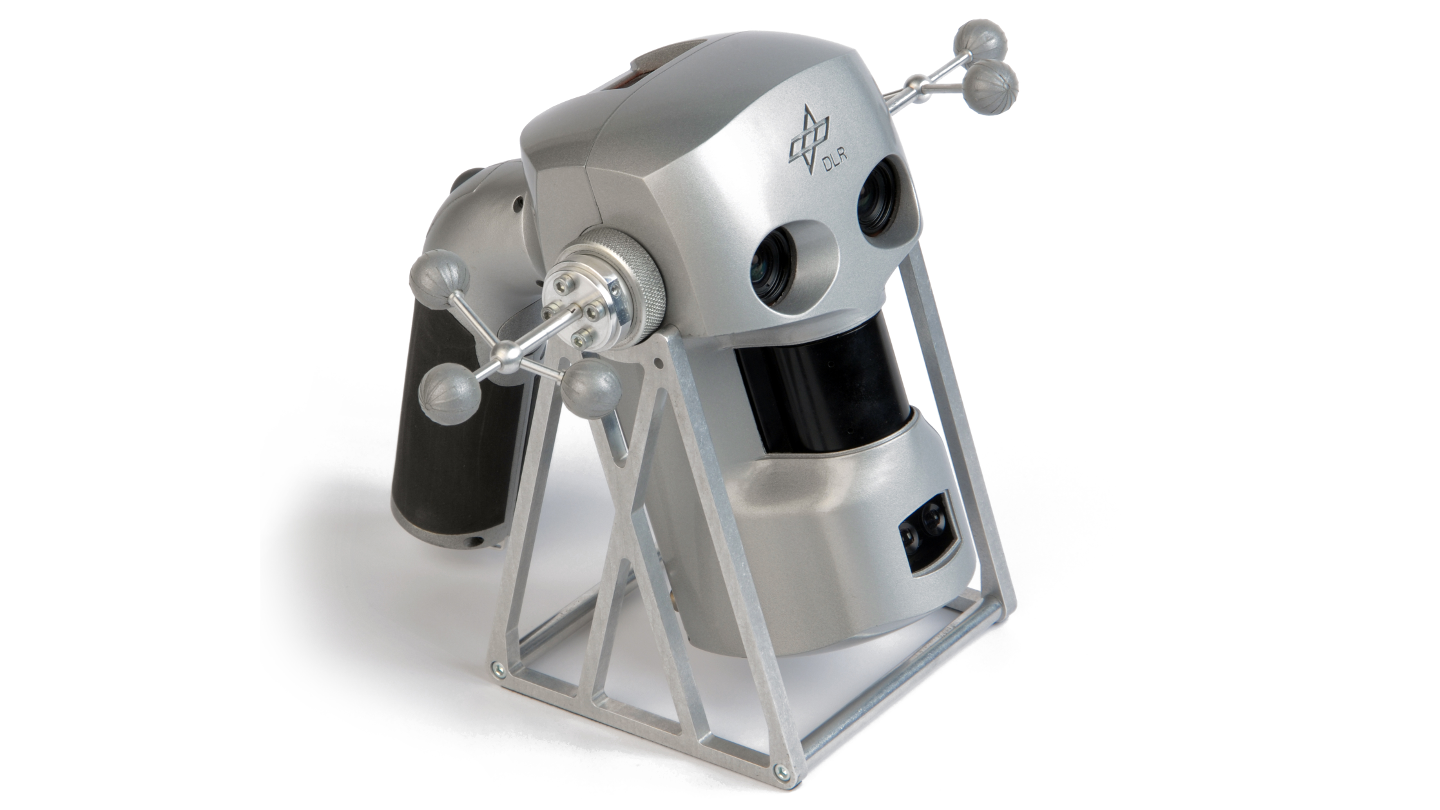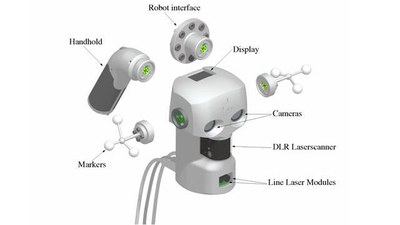3D Modeler (2006–2017)
The multisensory DLR 3D-Modeler is a device for fotorealistic 3-D modeling of a robot's environment in realtime.
In 2006, it was presented to the public for the first time.
Technical data
Size: | 17 cm × 20 cm × 11 cm |
Weight: | 850 g |
Sensors: |
|
Communication: | Ethernet over FireWire |
Workspace: |
|
Special features: |
|
System description
The DLR 3D-Modeler consists of a core module and application-specific extensions. The core module, hereafter called modeler, comprehends two digital cameras, a miniaturized rotating laser scanner and two laser line modules. Furthermore it features a small embedded computer to provide internal computing power and a graphical color display. The modeler can be attached to a handhold with various input buttons or to a robot via an industrial quick-changing adaptor. On the sides, markers can be attached for IR-based, optical pose tracking. Alternatively, an inertial measurement unit (IMU) can be attached.
Selected Publications
- K. H. Strobl, E. Mair, T. Bodenmüller, S. Kielhöfer, T. Wüsthoff, and M. Suppa. Portable 3-D Modeling using Visual Pose Tracking. Computers in Industry, Volume 99, August 2018, pp. 53-68, ISSN 0166-3615, https://doi.org/10.1016/j.compind.2018.03.009.
- K. H. Strobl. Loop Closing for Visual Pose Tracking during Close-Range 3-D Modeling. In G. Bebis et al. (Eds.): ISVC 2014, Part I, LNCS 8887, pp. 390--401. Springer International Publishing Switzerland (2014).
- K. H. Strobl, E. Mair, and G. Hirzinger. Image-Based Pose Estimation for 3-D Modeling in Rapid, Hand-Held Motion. Proceedings of the IEEE International Conference on Robotics and Automation (ICRA 2011), Shanghai, China, pp. 2593-2600, May 2011.
- K. H. Strobl, E. Mair, T. Bodenmüller, S. Kielhöfer, W. Sepp, M. Suppa, D. Burschka, and G. Hirzinger. The Self-Referenced DLR 3D-Modeler. Proceedings of the IEEE/RSJ International Conference on Intelligent Robots and Systems (IROS 2009), St. Louis, MO, USA, pp. 21-28, October 2009, best paper finalist.
- M. Suppa, S. Kielhöfer, J. Langwald, F. Hacker, K. H. Strobl, and G. Hirzinger. The 3D-Modeller: A Multi-Purpose Vision Platform. Proceedings of the IEEE International Conference on Robotics and Automation (ICRA 2007), Rome, Italy, 2007.
- K. H. Strobl, W. Sepp, E. Wahl, T. Bodenmüller, M. Suppa, J. F. Seara, and G. Hirzinger. The DLR Multisensory Hand-Guided Device: The Laser Stripe Profiler. Proceedings of the IEEE International Conference on Robotics and Automation (ICRA 2014), pp. 1927-1932, New Orleans, Louisiana, USA, April 26 - May 1, 2004.
- M. Suppa and G. Hirzinger. A Novel System Approach to Multisensory Data Acquisition. Intelligent Autonomous Systems 8 (IAS-8), pp. 996-1004, Amsterdam, March 10-13, 2004.



